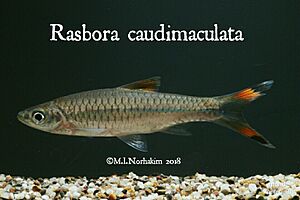Greater scissortail facts for kids
Quick facts for kids Greater scissortail |
|
|---|---|
 |
|
| Scientific classification |
The greater scissortail (scientific name: Rasbora caudimaculata) is a cool type of ray-finned fish. It belongs to the Rasbora family. You can find this fish swimming in forest creeks in countries like Malaysia, Indonesia, and the lower Mekong river area.
Contents
What People Call It
- The Merap community calls it Betelah.
- The Punan community calls it Beteluh.
- The Kenyah community calls it Beteloh.
- In Malay, it's known as Seluang Engkrunyuk.
- In Iban, people call it Enseluai.
About the Greater Scissortail
The greater scissortail is a fairly large Rasbora fish. It can grow up to about 15 centimeters (6 inches) long.
How to Spot It
This fish looks a bit like another fish called Rasbora trilineata. But there are a few ways to tell them apart. The greater scissortail has orange or red marks on its tail fin. These colorful spots are just before the black marks on the fin. Also, adult greater scissortails are usually bigger. Sometimes, their top fin (called the dorsal fin) might also have a light orange mark.
Where It Lives
The greater scissortail lives in different parts of Southeast Asia. Scientists are still figuring out its exact range. It's most likely found in the southern part of Peninsular Malaysia, the Greater Sunda Islands, and all of Borneo.
Fish Populations
In Borneo, you can find many greater scissortail fish. However, in Peninsular Malaysia, they are not as common. Their populations there are very small and found only in certain places. This might be because their natural homes are disappearing.
Its Home Environment
The greater scissortail is a speedy swimmer and can adapt to different places. It likes fast-flowing forest streams with sandy or rocky bottoms. It can also live in slow-moving, dark water, like rivers in peat swamps.
Hiding Places and Neighbors
In most of these places, the fish uses submerged plants or wood to hide. These hiding spots protect them from animals that might try to eat them. Young fish have even been seen near areas where Eusideroxylon zwageri trees grow.
Other fish often live alongside the greater scissortail. Some of these include the R. borapetensis, B. sealei, and B. kuchingensis. Sometimes, a fish called the Channa lucius might hunt and eat the greater scissortail.

